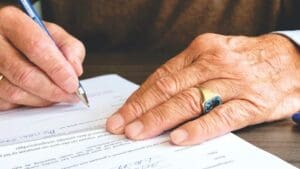Almost everything is digitized in today’s age, and we often assume that things like our personal data are secured. However, technology and digitization is a double-edged sword. Digitization is relatively more secure than physical documents. But at the same time, our personal information is exposed to new kinds of threats. Hackers and fraudsters have found new ways to steal identity by using technology. These shady characters now use both manual and digital methods to steal your personally identifiable information. This information includes your full name, Social Security number, address, or driver’s license number.
To protect yourself from identity theft, we must first learn about how these things happen in the first place. That way, you lessen the probability of exposing yourself to these risks.
Lost or Stolen Wallet
Grab your wallet and try to see how much of your personally identifiable information is on there. As you might come to realize, your wallet or purse contains a lot of your personal data. It is found on your debit and credit cards, driver’s license, Social Security card, and other important documents.
Prevention: Don’t keep all these important documents in your wallet or purse to reduce the risk of identity theft. Memorize passwords and identification numbers, such as your Social Security Number). You may also use secure password manager apps on your digital devices. For debit and credit cards, keep those that you use regularly and leave the rest in a safe place at home.
Mail Theft
Despite the availability of digital tools, fraudsters still rely on old fashioned methods like mail theft. Your vulnerability of identity theft is increased, especially if you receive bank and credit card statements, or send checks through the mail.
When you have an unsecured mailbox, thieves could easily obtain crucial information such as your bank account number and routing number. Fraudsters use this information to make credit charges to your account.
Prevention: Aside from getting a secured mailbox, you may opt to receive your bank statements and credit card bills electronically sent to your email address. You may also enroll your account or credit card to your bank’s online banking service. By registering for this service, you can frequently monitor your account for any unusual activity. If you need to send a check through the mail, send it through your local post office or give it directly to the mail carrier.
Trash Theft
We usually don’t think about what will happen to the things that we throw out. Fraudsters might also rummage through your trash to get your personal information.
Prevention: When you’re throwing out sensitive documents, the best way to dispose of it is to run it through a shredder. This way, no one can possibly put it back together to its original form.
Unsecured Digital Devices
Nowadays, you could do just about anything with a few taps on a digital screen. Your digital devices are gateways to important personal information. You probably have apps for your email, online banking accounts, and financial management tools installed on there. If your device is unsecured, you’re practically giving this information away to fraudsters.
Prevention: Set a password or PIN that will be required to access your device. This way, when someone finds or steals your device, they will have a hard time accessing your personal information. Add another layer of security for your device by installing a trusted anti-malware program.
Compromised Card Readers
Whenever we’re making purchases or withdrawals with our cards, we usually don’t overthink it. However, fraudsters have devised a way to steal information through skimmers. Skimmers (or shimmers) are devices placed over the card reader to collect valuable data. The device comes in contact with the magnetic stripe or chip of your card. When it does, the fraudster will now have a copy of your information. The information is often used to make fake credit or debit cards and charge them against your account.
Prevention: When using your card to make payments or purchases, check the card reader if anything seems off. You can also enroll your card to your online banking account so you could easily monitor unusual activity.
Phishing
Phishing scams come in the form of emails, texts, and voice calls to get you to share your personal information with them. Fraudsters usually pretend to be a representative from your bank and convince you that there is something wrong with your account. It is getting a bit difficult to determine if a message is legit or fraud. It is a phishing scam if the messages have these characteristics:
- Don’t address you by your name
- Requires immediate action
- Threaten you with a negative consequence
- Have a suspicious sender address (email) or number (text and call)
- Include spelling and grammar errors
- Include attachments
- Request information the institution they’re posing as already has (like your account or card number)
- Share vague information
Prevention: When you receive a suspicious email or text, look out for the characteristics listed above in their message. Don’t click on any links that might look suspicious. When you receive a suspicious call, don’t give out any personal information over the phone. To make sure that there is an issue with your account, call the customer services department of your bank.
Unsecure Internet Connections
Unsecure internet connections not only covers free public Wi-Fi, but it also includes the Wi-Fi connection of an establishment (such as cafes) and an unsecured home network. Because of these connections are insecure or aren’t secure enough, anyone could join in and steal your personal information.
Prevention: For your home network, set a strong password and change it every six to twelve months. For other Wi-Fi connections, don’t access websites that require you to type in your personal information, such as your online banking account. If you need to perform important transactions online such as verifycard, do them only when you’re connected to a secured network.
Data Breaches
Banks and other entities often do their best to keep our personal information secure. However, hackers might still be able to access your personal information through numerous methods. This situation is called a data breach. Whether it was accidental or intentional, data breaches cause security problems for both the organization affected and the individuals whose information was exposed.
Prevention: Be careful and selective about the personal information that you are sharing. Always ask yourself if it is necessary to share this information to complete the transaction. When shopping online, purchase from trusted companies instead of those with questionable reputations.
Damage Control During Identity Theft
What do you do once you find out your personal information has been compromised? While there is no absolute method to prevent identity theft, there are methods to stop it from getting worse. Here are some ways for damage control:
- Report lost or stolen debit or credit cards to your bank to block the card immediately
- Report unusual transactions or activities on your account
- Consider adding an initial fraud alert to your credit reports if your Social Security number has been compromised
- If an account has been opened in your name, contact the creditor and file a police report










